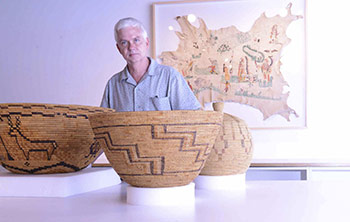Before he was cataloguing the nearly 10,000 pieces in the Pomona College Museum of Art (PCMA) collection, museum Associate Director and Registrar Steve Comba was earning a reputation among his fifth-grade classmates for copying Peanuts cartoons and drawing “Wanted” posters of his least favorite teachers—a feat which often got him into trouble. Comba still has a sharp, sly sense of humor, but when it comes to managing the College’s art collection, he’s all business.
 Comba never set out to work for a museum. As an undergraduate, he attended the UC Santa Barbara College of Creative Studies, later relocating to Claremont, where he received his MFA in Studio Art from the Claremont Graduate University in 1986. All he wanted was a teaching job that would enable him to pay the rent for his own studio. Until he could find a position, he took a part-time job photographing, mapping and framing prints at the Galleries of The Claremont Colleges, the former museum jointly run by Pomona and Scripps colleges. When two positions at the gallery opened up, Comba inquired about being gallery manager. “I thought it would be more appropriate for a studio artist to be the person who hangs the work, but the curator of collections thought I should look at the position of registrar instead,” he recalls. “My response was, ‘Okay…what is that?’”
Comba never set out to work for a museum. As an undergraduate, he attended the UC Santa Barbara College of Creative Studies, later relocating to Claremont, where he received his MFA in Studio Art from the Claremont Graduate University in 1986. All he wanted was a teaching job that would enable him to pay the rent for his own studio. Until he could find a position, he took a part-time job photographing, mapping and framing prints at the Galleries of The Claremont Colleges, the former museum jointly run by Pomona and Scripps colleges. When two positions at the gallery opened up, Comba inquired about being gallery manager. “I thought it would be more appropriate for a studio artist to be the person who hangs the work, but the curator of collections thought I should look at the position of registrar instead,” he recalls. “My response was, ‘Okay…what is that?’”
As it turns out, it’s a lot. Comba’s official job description is to track everything about every object in the museum, whether it belongs to the PCMA collection or is on loan from another institution. If someone needs to know where an object is and how it’s doing, Comba is the person to call. He also oversees conservation efforts of pieces that have seen better days. “I get a lot of personal gratification when I’ve done something for an object that I know will further its preservation,” he says.
But for Comba, being the museum’s registrar is more than just cataloguing. When his daughter was a student at Sycamore Elementary, he enjoyed being able to supplement her class’s lessons about native peoples by bringing in real Cherokee sandals. Now he is one of the main coordinators of the museum’s two-year-old outreach program to local third grade classes. In the College-sponsored program, students take a field trip to the museum to see in person the artifacts they studied in the classroom. Comba advocates a hands-on approach, sometimes even letting students wear gloves and pass around a 130-year-old Cherokee lacrosse ball. He works hard to structure his lessons so that students have an opportunity to see the continuity of culture.
Comba is also an active figure in the museum’s internship program. He has been in the museum business so long—July marked his 28th year with PCMA—that several influential figures behind the doors of larger institutions, such as the registrar of Pasadena’s Norton Simon Museum, were his students. However, the most rewarding part of the job for Comba is still his intimate connection to the art. “At a certain point, you can say it’s no longer a choice,” he explains. “The need becomes ingrained in the DNA. Whenever we travel on vacation and we’re anywhere within reasonable distance of a museum, my family knows that I’m going to start to sweat if I don’t get to go in there and see it. I was asked how I get ideas for my paintings and it’s the same thing. I no longer have to look for them, because every time I look out I see the world through a painting.”
As for the future of PCMA, Comba says that talk of a new, larger museum is in the works. With a collection that grows by 100 to 170 objects a year, adding more space only makes sense. “A museum isn’t just about the contents,” he explains. “It’s a place. The place either enhances or detracts from the experience of the visitor. What’s exciting about the future is that our desire to expand is not just about making the museum bigger. It’s about having that relationship be fundamentally better. It’s an exciting thing to be a part of.”
And yet, playing such a vital role in running a college museum was never what Comba initially imagined he would end up doing. “I lucked into it. It wasn’t a plan, but this gig with the museum is working out,” he says, laughing. “If you asked, I’d say I still don’t know what I want to be when I grow up.”
